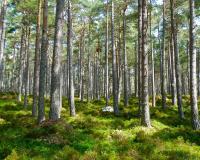
Vibrant Environment
All | Biodiversity | Climate Change and Sustainability | Environmental Justice | Governance and Rule of Law | Land Use and Natural Resources | Oceans and Coasts | Pollution Control

One of the first civilizations to arise after humankind left Africa was in a nearby region that is in present-day Iraq and parts of neighboring countries stretching to the Mediterranean Sea. It has been dubbed by chroniclers Mesopotamia, Greek for “the land between two rivers.” The Tigris and Euphrates valley was the setting for the biblical Garden of Eden and is aptly named the Fertile Crescent in history books today.

Candidly, I gave up making New Year’s resolutions long ago. We all know about the January spike in gym memberships that falls off a cliff come March. On the other hand, I always look forward to spending time in December looking back and pondering priorities for the year to come. Here are a few of the things starting to circle in my mind.

The Inflation Reduction Act’s (IRA’s) increase of the 45Q tax credit has created a bonanza around carbon removal.

This is Part 2 of a two-part blog series on environmental audits/assessments. The below article discusses the key characteristics of a robust assessment program. To learn more, check out the latest edition of ELI’s Law of Environmental Protection.
What are the key characteristics of a robust assessment program?

It’s a fact recognized by every well-behaved child: the attention always goes to the misbehaving sibling or classmate. Similarly, companies with strong environmental audit/assessment programs rarely receive much acclaim, despite publicizing their efforts in great detail. And why should they? These gold-star companies have minimal interaction with the enforcement arms of federal and state agencies.

Innovations in U.S. environmental law traditionally occur at the state level, and environmental justice is no exception. Due to the highly polarized environment on Capitol Hill, current efforts to enact a federal EJ law have yet to survive the legislative process. One recent example was the Environmental Justice for All bill that did not even reach the House floor for a vote before the end of the 117th Congress session.

When a colleague asked me what exactly I meant by political ecology during a recent meeting, I was genuinely surprised.

A longstanding problem for solar farms has a surprisingly cute solution. “Sheep are the solar industry’s lawn mowers of choice,” writes Amrith Ramkumar in the Wall Street Journal. Farmers maintaining thousands of acres of panels need to contend with tall grasses, which, unabated, can obstruct sunlight. Enter the star of nursery rhymes and an unexpected hero of renewables. Hard-working flocks are now generating millions of dollars in annual revenue by helping to chomp on pesky weeds.

When I last sat down to write this column, the Supreme Court had just issued its 6-3 decision in West Virginia v. EPA. As I said at the time, it was disheartening, and many in the environmental law field were assessing how to bounce back from its potential effects limiting agency action. Fast-forward two months, and while the concerns raised by that case aren’t gone, we’ve spun in the other direction.

Alicia Mozian, recipient of the 2017 National Wetlands Community Leader Award, retired in October after 35 years of dedication to environmental sustainability in Connecticut. Mozian served over two decades as the Conservation Department Director of Westport, overseeing most aspects of Westport’s environment.